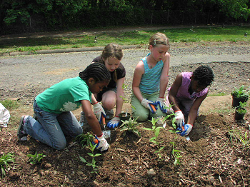How Maryland is Cleaning the Chesapeake Bay
The Chesapeake Bay Cleanup Plan
The Chesapeake Bay Cleanup Plan consists of five key elements that are designed to make concrete steps towards reducing pollution in the Bay:
-
Chesapeake Bay Total Maximum Daily Load (TMDL)
The Chesapeake Bay TMDL is the scientific estimate of the maximum amount of nutrient pollution the Bay can receive and still remain healthy and meet state water quality standards. Geographically, the TMDL is broken down into multiple smaller TMDLs by state, and within states, by watersheds.
For Maryland, the Bay TMDL sets annual limits of 41.2 million pounds of nitrogen, 2.8 million pounds of phosphorus, and 1.3 billion pounds of sediments. Achieving these pollution limits is equivalent to a 20.8%, 14.9%, and 3.2% reduction of nitrogen, phosphorus, and sediments respectively that Maryland must make to restore the Chesapeake.
Why is Maryland Cleaning the Bay?
Nutrient pollution from humans has caused great harm to the Chesapeake Bay.
Maryland recognizes the problems faced by the Bay and has taken measures to clean up pollution and restore the Chesapeake.
Learn More
As part of their 2017 Midpoint Assessment (leaving MDE), the EPA expects all Bay states to have 60 percent of their 2025 restoration targets achieved for nitrogen, phosphorus, and sediment.
Learn more about the Chesapeake Bay TMDL (leaving MDE).
-
Watershed Implementation Plans (WIPs)
Watershed Implementation Plans, or WIPs, detail the steps, measures, and practices that Maryland and other Bay states must implement to meet their pollution reduction goals specified by the TMDL.
Maryland's Phase I WIP was published in 2010 and served as the foundation for how Maryland would reach the 2025 Bay cleanup goals. The Phase II WIP, developed in 2011, refined the Phase I WIP by incorporating improved geographic capabilities for targeting pollution loads. A Phase III WIP will address the pollution reductions needed from 2018 to 2025. Each new WIP incorporates improved data, improved understandings of natural systems, and enhanced technical analysis tools to better determine pollution loading rates.
Learn more about Maryland's Phase III WIP.
Learn more about how WIPs guide Chesapeake Bay cleanup (leaving MDE).
-
Two-Year Milestones
Looking for WIP Development?
MDE provides outreach, guidance, and technical assistance for developing and implementing Watershed Implementation Plans.
Learn More
To promote continuous cleanup progress, the United States Environmental Protection Agency (EPA) calls for states to identify milestones and reach them in two-year increments. These near-term commitments ensure states continue to make progress towards meeting cleanup strategies detailed by the WIPs.
Learn more about how Two-Year Milestones ensure cleanup progress (leaving MDE).
-
Best Management Practices (BMPs)
Best Management Practices (BMPs) are the collection of actions, policies, and structures specified in the WIP and Two-Year Milestones used to reduce nutrient pollution. BMPs are local level pollution reduction measures and are directly responsible for cleaning the Chesapeake.
Learn more about the process of ensuring BMPs are cleaning the Bay (leaving MDE).
-
Maryland’s Tracking and Accountability System
Maryland tracks and reports Chesapeake Bay restoration to demonstrate progress towards cleanup goals. Included in Maryland’s tracking system are the completion of Two-Year Milestones, and annual progress reports that track BMP implementation and nutrient pollution reductions.
Local Involvement
 Planting a rain garden is one of many ways to get involved in Bay restoration.
Planting a rain garden is one of many ways to get involved in Bay restoration.
Image courtesy of Alliance for the Chesapeake Bay.
Maryland counts on its citizens to help clean the Bay. In addition to local governments, citizens, business owners, faith communities, homeowners associations, and other non-government organizations are all integral to realizing successful Chesapeake Bay cleanup.
These individuals and organizations perform invaluable services by providing their time, money, and energy to help clean the Bay. These non-government partners in Bay restoration help accomplish individual projects on private property that would otherwise not be possible.
Learn more about how you can make a difference in your community.
How did the Cleanup Plan Originate?
The Chesapeake Bay cleanup plan is a direct response to excess nutrient pollution that harms the health of the Bay.
What started out as a simple pledge to reduce nutrients has evolved into a full-fledged cleanup plan with measures and controls to guarantee successful Bay restoration.
Learn More
How does the Cleanup Plan Restore the Bay?
A Roadmap to Clean the Bay
Each one of the elements of the Bay Cleanup Plan acts as parts of a roadmap to a destination. For Bay cleanup, our destination is the TMDL. Watershed Implementation Plans serve as the roadmap and show how we will get to our destination. While drawing closer to our goal, states revise and improve WIPs based on the latest water science. Along the way, we set and meet milestones to make sure we do not stray from our path. To move down the road towards our destination, we must implement BMPs and reduce pollution.
Holding States Responsible for Bay Cleanup
The hypothetical roadmap described above forms what is known as an accountability framework. This structure holds the Bay states responsible for Chesapeake Bay cleanup and assures states make adequate cleanup progress by 2025.
The EPA is required under the Chesapeake Bay TMDL and accountability framework to assess WIPs and Two-Year Milestones. If the EPA deems that a state’s pollution reduction strategy to implement TMDL goals is not sufficient, they may take additional federal actions.
Learn More about how the EPA holds states accountable for Bay Cleanup (leaving MDE).
Up Next: Demonstrating Cleanup Success
Charts, data, reports, and success stories demonstrate progress towards cleanup goals and reaffirm Maryland’s commitment to Bay restoration.
Learn more about Chesapeake Bay Cleanup Progress.
Contact Information
Please direct questions or comments to mde.chesapeakewip@maryland.gov.